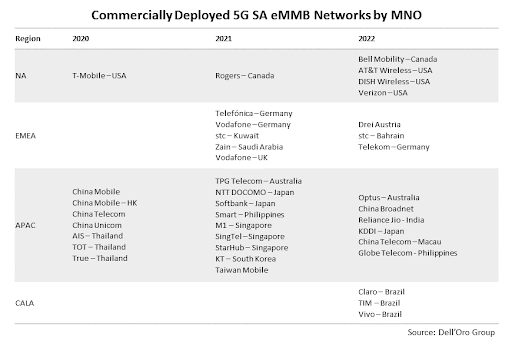The number of mobile operators launching out cloud-native standalone (SA) 5G grew to 39 globally by the end of 2022, Dell’Oro Group research director Dave Bolan told Silverlinings, adding that he expected more carriers to launch this year.
Bolan emailed us an updated chart of global mobile network operators (MNOs) that have fully or partially deployed 5G SA on their networks. The number of operators is up from 36 in November 2022.
“We do expect more to launch in 2023,” Bolan told Silverlinings in an email. “Many MNOs are prepping their networks for 5G SA already.”

Bolan commented in his 2023 prediction blog that Reliance Jio, China Telecom-Macau and Globe Telecom came to the rescue in the fourth quarter pushing the number of 5G SA networks launched in 2022 over the 2021 total. “Reliance Jio has announced a very aggressive deployment schedule to cover most of India by the end of 2023,” Bolan said.
Download speed racer
Cloud-native 5G SA represents a step up in performance over 5G radio access networks (RAN) that still use the 4G control plane for routing, handover and more. This overall performance hike is evidenced in how T-Mobile handily beat major rivals AT&T and Verizon in nearly all the major categories laid out in Ookla’s latest U.S. speed test
T-Mobile was the first major operator in the world to roll out 5G SA on its nationwide 600MHz 5G network in August 2020. It switched on SA on its faster 2.5GHz network in November 2022.
T-Mobile users will initially see download speed increases from the pure 5G move as the operator rolls out carrier aggregation (CA) that combines 5G bands of the same — or different — frequencies to give a data speed boost.
AT&T and Verizon, meanwhile, have said that they have started moving customers to their respective 5G SA cores but little more than that yet. Dell’Oro’s Bolan expects large expansions from both operators on the standalone front in 2023.
In February 2022, Dish implemented its SA 5G core on the Amazon Web Service cloud, giving the greenfield contender a massive time-to-market advantage, according to Dish Executive Vice President of Network Development, Dave Mayo.
He told Silverlinings that its cloud-native network will give Dish a substantial leg-up in the enterprise space. “We will be able to deploy core network elements in enterprise locations and mitigate the need for those enterprises to send their data back to our switching center,” Mayo said. “That’s a really big deal,” because certain industries [For instance, banks and hospitals] just really don’t want their data leaving their facilities, he added.
Original article can be seen at:
